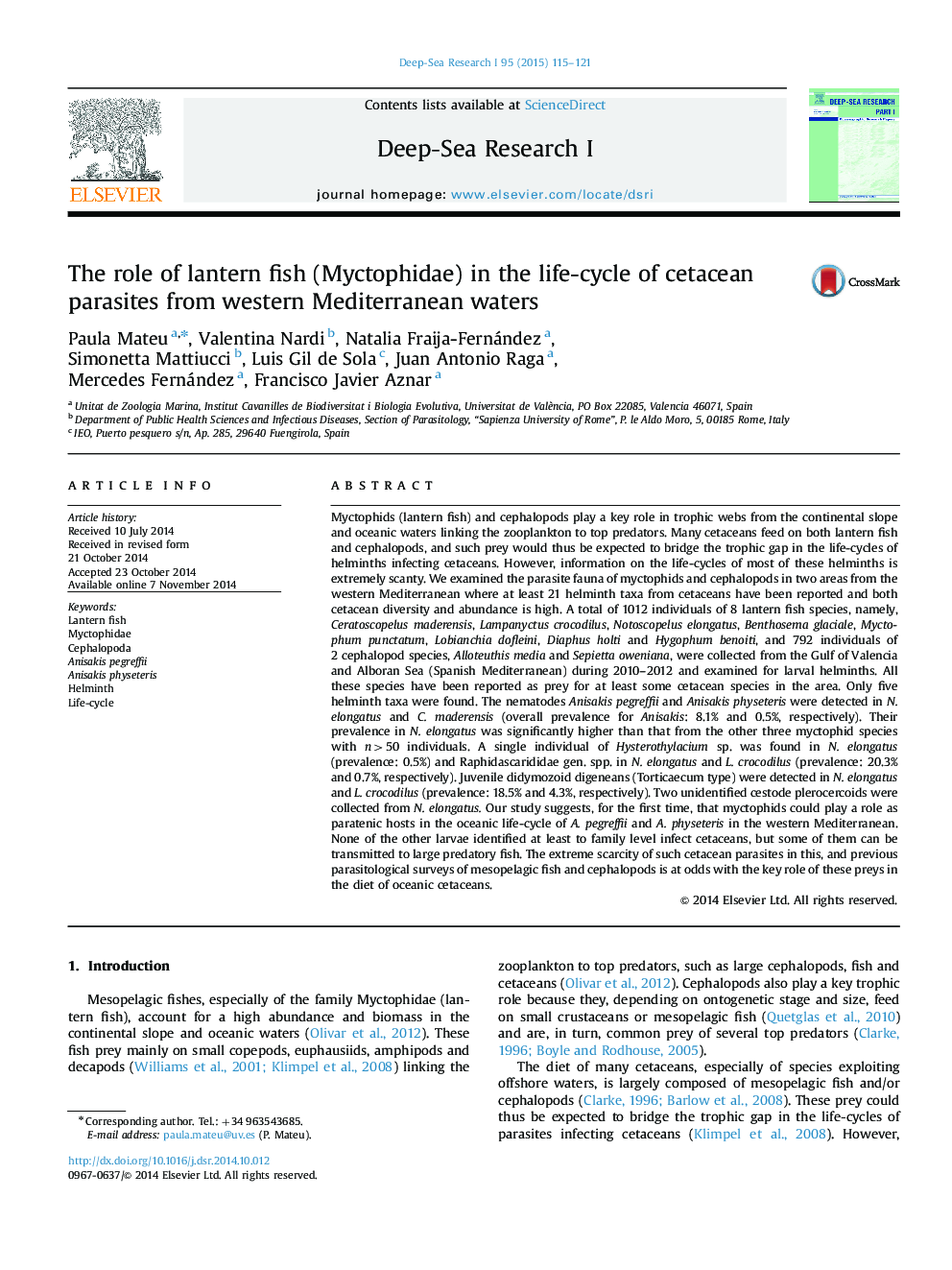| کد مقاله | کد نشریه | سال انتشار | مقاله انگلیسی | نسخه تمام متن |
|---|---|---|---|---|
| 6383580 | 1626335 | 2015 | 7 صفحه PDF | دانلود رایگان |

- We studied eight lantern fish and two squid species for larvae of cetacean helminthes.
- Nematodes Anisakis pegreffii and Anisakis physeteris were dominant in myctophids.
- No parasites were found in squids.
- Anisakis physeteris is reported for the first time in myctophids.
- Notoscopelus elongatus seems involved in the life-cycle of both Anisakis spp.
Myctophids (lantern fish) and cephalopods play a key role in trophic webs from the continental slope and oceanic waters linking the zooplankton to top predators. Many cetaceans feed on both lantern fish and cephalopods, and such prey would thus be expected to bridge the trophic gap in the life-cycles of helminths infecting cetaceans. However, information on the life-cycles of most of these helminths is extremely scanty. We examined the parasite fauna of myctophids and cephalopods in two areas from the western Mediterranean where at least 21 helminth taxa from cetaceans have been reported and both cetacean diversity and abundance is high. A total of 1012 individuals of 8 lantern fish species, namely, Ceratoscopelus maderensis, Lampanyctus crocodilus, Notoscopelus elongatus, Benthosema glaciale, Myctophum punctatum, Lobianchia dofleini, Diaphus holti and Hygophum benoiti, and 792 individuals of 2 cephalopod species, Alloteuthis media and Sepietta oweniana, were collected from the Gulf of Valencia and Alboran Sea (Spanish Mediterranean) during 2010-2012 and examined for larval helminths. All these species have been reported as prey for at least some cetacean species in the area. Only five helminth taxa were found. The nematodes Anisakis pegreffii and Anisakis physeteris were detected in N. elongatus and C. maderensis (overall prevalence for Anisakis: 8.1% and 0.5%, respectively). Their prevalence in N. elongatus was significantly higher than that from the other three myctophid species with n>50 individuals. A single individual of Hysterothylacium sp. was found in N. elongatus (prevalence: 0.5%) and Raphidascarididae gen. spp. in N. elongatus and L. crocodilus (prevalence: 20.3% and 0.7%, respectively). Juvenile didymozoid digeneans (Torticaecum type) were detected in N. elongatus and L. crocodilus (prevalence: 18.5% and 4.3%, respectively). Two unidentified cestode plerocercoids were collected from N. elongatus. Our study suggests, for the first time, that myctophids could play a role as paratenic hosts in the oceanic life-cycle of A. pegreffii and A. physeteris in the western Mediterranean. None of the other larvae identified at least to family level infect cetaceans, but some of them can be transmitted to large predatory fish. The extreme scarcity of such cetacean parasites in this, and previous parasitological surveys of mesopelagic fish and cephalopods is at odds with the key role of these preys in the diet of oceanic cetaceans.
Journal: Deep Sea Research Part I: Oceanographic Research Papers - Volume 95, January 2015, Pages 115-121